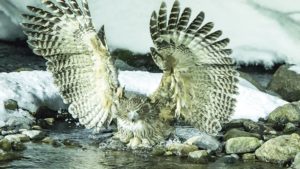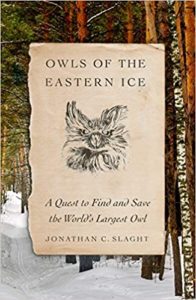OWL OF THE EASTERN ICE by Jonathan Slaght (Russia) — a review
Owls of the Eastern Ice by Jonathan C Slaght
review – an extraordinary quest
Drinking ethanol and saving the world … an old-school, tautly strung adventure in pursuit of the largest species of owl
review by Helen Macdonald, 22 July, The Guardian
 Jonathan Slaght has the best author photograph I’ve ever seen. Pale, bearded, dressed in black, he gazes at the camera with forbidding intensity. Behind him are snowy woods and running water. Arms crossed, hands deep in a pair of unwieldy leather gauntlets, he holds against his chest a huge owl. Its feathers are shaggy and wet, and from its mouth protrudes the tail end of a silver fish. There’s something puppet-like about this creature, like a living Jim Henson creation, but it also resembles a beast pulled straight from the pages of a medieval bestiary – which is fitting, because Owls of the Eastern Ice reads like a modern-day grail quest: a tale of one man’s travels through a daunting landscape of snow and ice and radioactive rivers, searching for an animal that seems all ghost.
Jonathan Slaght has the best author photograph I’ve ever seen. Pale, bearded, dressed in black, he gazes at the camera with forbidding intensity. Behind him are snowy woods and running water. Arms crossed, hands deep in a pair of unwieldy leather gauntlets, he holds against his chest a huge owl. Its feathers are shaggy and wet, and from its mouth protrudes the tail end of a silver fish. There’s something puppet-like about this creature, like a living Jim Henson creation, but it also resembles a beast pulled straight from the pages of a medieval bestiary – which is fitting, because Owls of the Eastern Ice reads like a modern-day grail quest: a tale of one man’s travels through a daunting landscape of snow and ice and radioactive rivers, searching for an animal that seems all ghost.
A confession: I’ve never understood why so many people are obsessed with owls. I once cared for a rescued barn owl, and while it was a beautiful creature, possessing a cat-like hauteur and strangely human face, it was about as rewarding to interact with as a porcelain statuette. But I’m happy to report that this book has changed me. I have become an ardent fan of the largest living species of owl, the Blakiston’s fish owl. Huge, elusive and endangered denizens of the deep forests of Japan, China and the Russian far east, these marvellously odd birds wade through icy water to catch fish, sing in low, hooted duets, possess a thick layer of insulating fat, a wingspan that can top six and a half feet, and have been venerated as gods by the Ainu of Hokkaido.
They are, in short, superb owls. The first one Slaght sees seems hardly a bird at all, more a “dishevelled mass of wood-chip brown”, as if “someone had hastily glued fistfuls of feathers to a yearling bear, then propped the dazed beast in a tree”. As that gem of a description shows, Slaght has a rare gift for startling evocations of the natural world – a nightjar’s call is like someone chopping cucumbers, the K-shaped footprint of an owl in deep snow is tipped with talon-raked lines like “a spur-heeled cowboy in the rodeo dust”
Owls of the Eastern Ice is a record of John Slaght’s (Russia 1999-02) four seasons of fieldwork in the remote forests of Primorye, a region of Russia bordering North Korea and the Sea of Japan. The goal of his project was to search for fish owls, trap them, tag them, then trace their movements to find out the precise nature of the habitat they used, so their breeding and hunting sites could be protected from destruction by logging companies. “How hard could it be?” he writes, as he begins his research. Quite hard, it turns out. There are floods, roadblocks, storms, wildfires, vehicles sinking through ice, malfunctioning technologies, night-long subzero vigils on riverbanks, hangovers from drinking industrial ethanol, and a whole cavalcade of fascinating and sometimes criminal associates. There are stories within stories in the pages of Owls of the Eastern Ice: encounters with drowning deer and a Russian intelligence agency, fishermen drifting lost on open seas, a hermit who believes in teleportation living in a cabin in an abandoned hydroelectric station, and the unforgettable story of a local man bent on revenge against owls after losing a testicle to a young one’s talons while crouching to defecate in the woods.
Primoye is a remarkable place, and Slaght’s passion for it is palpable; his fascination with fish owls, too, the reader quickly understands and shares. But I can’t help feeling that the real subject of this book is neither forests nor owls, but fieldwork. Having conducted fieldwork in remote places myself, camping among the burrows of plague-stricken rodents, dining on ancient corroded tins of Soviet beef, and tracking raptors using hand-held radio receivers (hint: never try this near military installations), I can assure you that it is not, as many people assume, anything like a vacation.
Slaght is a wonderful guide to the reality of fieldwork, a pursuit marked by tests and tribulations that will inspire and drain you, corrode your faith and devotion to your cause, induce vast mood-swings that range from despair to dizzying elation, and that requires a suite of personal and practical skills far from those of a lab-bound scientist. His quest has deep moral, as well as personal significance. In conservation biology, you are always working towards redemption. Your task is to gain knowledge that will help save the world, or at least part of it.
Unlike much current nature writing, Owls of the Eastern Ice does not treat encounters with wild creatures as opportunities for the writer to explore their own emotional and psychological landscape, or to kick-start a discussion of literature, philosophy or social history. In this regard, Slaght’s book is refreshingly old-school, a tautly strung adventure featuring not just the narrator, but his co-workers, his crew. These men crowd the pages fabulously;they include field-team leader Sergei Avdeyuk, with his cropped hair, gold teeth, swaggering gait and perpetual cigarette. As Slaght explains of his assistant Shurik, professional field assistants in many parts of the world conduct biological survey work out of economic necessity, rather than from the all-consuming love of nature we tend to assume lies behind careers in biology. For them, says Slaght, an owl is “just another bird”.
Like hunting culture, the culture of fieldwork has traditionally privileged virile masculine identities, and Slaght confesses that in this regard he doesn’t always live up to local expectations. He doesn’t hunt or fish, his American technical wear is hopelessly outmatched by the Russian environment, and he’s mocked by Sergei for his snowmobile driving style. But with his fluent Russian, detailed knowledge of the region, humour, physical strength and stamina, and (not least) his ability to take a Russian sauna in the correct manner, he is revealed as something of a go-between, a figure able to bridge and join the cultures of Russia and the US, science and non-science, and the bonds he forges with his colleagues are deep and abiding.
Today, most conservation scientists live in a constant state of anticipatory grief, for the organisms and systems they study tend to be slipping fast toward extinction. Slaght’s research project was unusual not only because the owl’s forest habitat was relatively pristine, but because the logging companies threatening it were willing to preserve the critical habitat the owls require. But as the epilogue to Slaght’s book reveals, merely protecting habitat from human exploitation might not be enough in an era of accelerating climate change. In 2016, after the Lionrock typhoon turned much of his study area into a wildland of debris, Slaght returned, fearing the worst. Searching for owls in a scene of unbridled devastation, he almost loses hope. But – and how my heart leapt, reading it – he finds the owls still there. They have simply moved a few kilometres. He locks eyes with the female perched at her new nest tree before she spooks and tears herself away into flight, a magnificently resilient creature carried on soft wings across her wilderness of broken trees.
•
Jonathan C. Slaght (Russia 1999-02) is the Russia and Northeast Asia Coordinator for the Wildlife Conservation Society. He received an undergraduate degree in Russian Language from Drew University (Madison, NJ, USA) in 1998, then served in the United States Peace Corps in Primorye, Russia between 1999-2002, where he lived in the villages of Lazo and Ternei teaching English and Environmental Education. He received a Master’s Degree in Conservation Biology (2005) and a Ph.D. in Wildlife Conservation (2011) from the University of Minnesota (St. Paul, MN, USA) studying birds in the Sikhote-Alin Mountains in eastern Russia. He is considered one of the world’s foremost experts on Blakiston’s fish owl.
Jonathan’s 2016 translation of Vladimir Arsenyev’s 1921 classic “Across the Ussuri Kray” (Indiana University Press) was favorably reviewed in The New Yorker, LA Review of Books, Times Literary Supplement, and more. He has authored several dozen scientific and popular publications and translated numerous scientific and popular texts from Russian. In addition to several television appearances, his writings, research, and photographs have been featured in The New York Times, National Public Radio, Smithsonian Magazine, and Audubon Magazine, among others. He writes a guest blog for Scientific American titled “East of Siberia,” and is a regular contributor to the Wildlife Conservation Society’s Wild.
•
Owls of the Eastern Ice: A Quest to Find and Save the World’s Largest Owl
by Jonathan Slaght (Russia 1999-02)
Farrar, Straus and Giroux
368 pages
August 2020
$27.49 (Hardback),$14.99 (Kindle)


Congratulations, Jonathan, on conducting and documenting this carefully planned, fascinating study and in an inhospitable part of the world (different than Russia’s western side, where I served). Thanks, Steven Saum, for identifying this meaningful review.
I am in need of a good book to read and this seems to be perfect for someone like me with my interest and concerns. I’m also glad to learn about
Peace Corps writers. Thank you